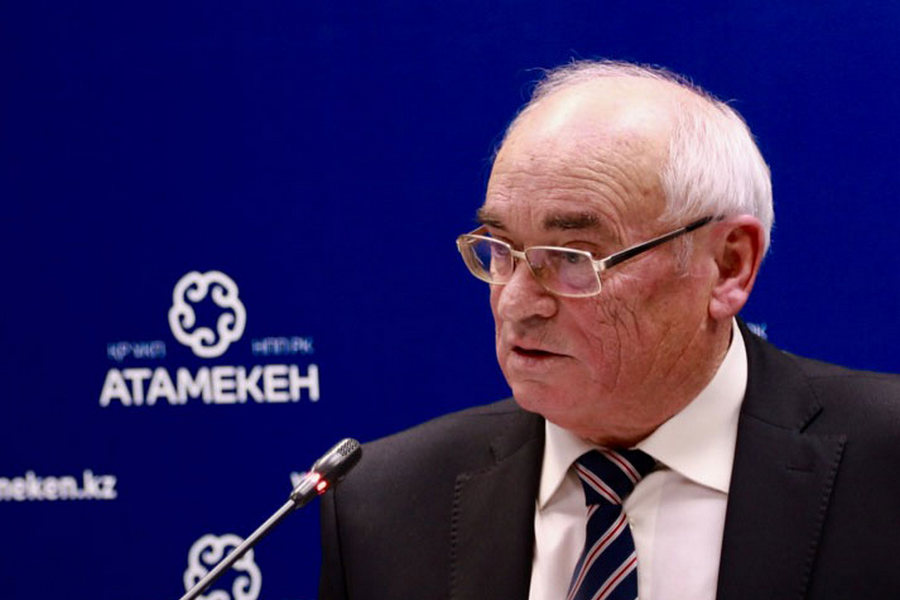President of Blockchain and Digital Mining Association Daniyar MUBARAKOV:
KAZAKHSTAN IS SHIFTING FROM RESTRICTING CRYPTOCURRENCY MINING TO ITS DEVELOPING

In recent years, cryptocurrency mining in Kazakhstan has faced stringent legal and tax regulations, becoming an outcast in the country's economic agenda. In the fight against "gray" miners -- those that steal electricity -- harsh laws were enacted, complicating life for legitimate market players and stifling the growth of crypto mining in the country. However, the need for new tax revenues amid budget shortfalls and for investments in aging energy infrastructure appear to have prompted the authorities to reconsider their stance on mining. In March, at the National Kurultai (Assembly), the country’s president called for urgent measures to liberalize the regulation of digital mining and cryptocurrency transactions. Daniyar MUBARAKOV, president of the Blockchain and Digital Mining Association, told Interfax-Kazakhstan in an interview about the existing problems and future plans of the domestic cryptocurrency mining industry.
- President of Kazakhstan Kassym-Jomart Tokayev has called for liberalizing the digital asset industry, particularly by attracting investments in cryptocurrency mining. How surprising was this directive from the head of state, given that negative perceptions of miners have dominated public discourse in recent years?
- The image and reputation of cryptocurrency miners have been heavily demonized over a long period. This negativity was primarily fueled by a lack of understanding of the intricacies of digital mining, as well as accusations of strain on the power grid -- issues often exacerbated by illegal market players.
Today, attitudes toward cryptocurrency mining have fundamentally shifted. People are beginning to recognize that mining is an industrial process that produces a highly valuable, albeit intangible, product, which is Bitcoin. Bitcoin has revolutionized payment systems and emerged as a new investment asset. The power supply organizations now see mining as a replacement for expensive peaking power plants and a tool for balancing the power grid. Tax authorities have observed tangible revenues; over the past three years miners have paid more than 17 billion tenge in taxes.
The government of Kazakhstan has turned its attention to other countries where mining is supported by the government, for instance the United States. It’s no coincidence that President Tokayev referenced the United States during the National Kurultai (Assembly) when discussing the development of the digital asset industry. The United States currently leads the world in cryptocurrency mining, annually generating $4.1 billion in tax revenues from the miners. The cryptocurrency mining industry has created 31,000 jobs across the country. In Texas alone, mining operations have helped save $18 billion by reducing the need to build peaking power plants, particularly gas-fired plants.
In 2021, Kazakhstan ranked second globally in Bitcoin mining after the U.S. Just imagine the results we could have achieved if digital mining had received state support much earlier.
No doubt, cryptocurrency mining can drive Kazakhstan’s technical and economic growth, including tax revenues and job creation.
- How does the government envision collaboration with the miners? Specifically, what role could the miners play in modernizing cogeneration heat and power plants (CHPs)?
- The key idea is that investors finance the construction of new power generation units at the existing power plant whenever it is possible. In return, 70% of the additionally generated electricity will be sold directly to data centers (DCs) supporting cryptocurrency mining or artificial intelligence, and the other 30% will be fed into Kazakhstan’s power grid.
The Ministry of Energy has identified several CHPs that have an expansion capacity, and draft amendments to relevant legislation have been prepared to facilitate this initiative.
Foreign investors have already expressed their interest, for the miners are reliable, creditworthy consumers that purchase electricity at a steady rate without fluctuations, which benefits power generation equipment. Few other bulk electricity consumers are willing to prepay for power as miners do.
Any energy professional will tell you that when building a nuclear power plant (NPP) -- which lacks the flexibility of peaking capacity -- you must consider how to handle excess electricity during low-demand periods. The NPP cannot change the power generation in a minute but the miners can consume massive amounts of power in seconds, thus effectively balancing the grid.
- Could you please describe the current status of the cryptocurrency mining industry in Kazakhstan? What problems is the industry currently facing?
- The digital mining industry is still adapting to stringent regulatory requirements that have made market entry exceedingly difficult. If the government aims to achieve the economic benefits I outlined earlier, the mining regulations should be adjusted accordingly.
Key concerns include taxation policies on imported computing equipment for data centers, which hinder upgrades to outdated hardware. Another major issue is the mandatory sale of 75% of mined Bitcoin through the cryptocurrency exchanges of the Astana International Financial Center (AIFC), and this requirement should be abolished.
The Association reckons that artificially enforced liquidity that is achieved through compelling the miners to sell their Bitcoin will eventually harm the operation of the AIFC’s cryptocurrency exchanges, for it is healthy competition that stimulates the emergence of strong companies that provide high-quality services. There have been instances when the miners could not sell their Bitcoin through the AIFC’s cryptocurrency exchanges because the latter lacked liquidity. However, the miners still did need to cover their operational costs like salaries and electricity and others.
Additionally, this requirement has deterred foreign investors from placing computing equipment in local mining data centers.
Another critical restriction is the "single-activity" rule, which prevents the miners from diversifying their operations. Currently, the miners are not allowed to install in their data centers servers supporting AI and other computing operations, nor can they sell the excess heat that their data centers generate.
For instance, in one of Canada’s provinces, the miners eliminated the need for strawberry imports from Mexico by supplying waste heat to nearby greenhouses. Similarly, Kazakh miners who relocated to Finland now provide heating for residential areas, thus becoming an integral part of the country’s energy infrastructure.
The domestic cryptocurrency mining industry also seeks a transparent framework for deploying mining facilities at oil and gas fields, where they could utilize the electricity that might be generated during the processing of high-sulfur associated petroleum gas, which is not the sale gas supplied to customers or exported but the associated gas that is normally flared. In this way, the oil and gas companies could generate additional income by selling electricity to cryptocurrency miners. Furthermore, the oil and gas companies will not have to pay environmental fines anymore. As a result, tax revenues to the republic’s budget will increase as well. Such practices are already in place in the U.S. and Russia, including at Gazprom’s facilities.
- Will there be changes in the legislation regarding energy consumption and sources for cryptocurrency miners?
- The law defines a list of permitted energy sources for digital miners. Firstly, there is a quota, which is set using the following formula: "The total power production in the republic minus consumption." The remaining surplus is sold to the miners through an ascending-price auction. Typically, such volumes are available during nighttime hours. Secondly, electricity is imported from the neighboring power grids. The third option is independent, off-grid generation not connected to the national power grid. Finally, the power can be supplied by renewable energy sources that do not have investment agreements.
In future, if a clear and a transparent mechanism is established allowing for the miners’ location at gas processing plants with associated petroleum gas, the cryptocurrency miners could use electricity that would be produced in the course of gas processing. Estimates suggest that about 100 MW could become available for the miners in this case. It can be oil and gas fields where the processing of associated gas is economically unfeasible or where the gas is flared. We are open to a dialogue with the oil and gas companies concerning this possibility.
Furthermore, there is the 70/30 program that is under development at the moment and that is expected to provide the market with additional volumes of electricity in the long term.
Electricity can also be generated during biomass processing, so we are also ready to discuss prospects for cooperation with agricultural companies in this area.
- How many cryptocurrency miners currently operate in Kazakhstan? Who are they? What does the average crypto farm manager look like?
- Today, Kazakhstan has issued licenses to 64 cryptocurrency miners, though not all of them are necessarily in business. The miners in the country fall into two categories depending on their licenses: Category 1 miners (29 farms) that own both infrastructure and computing equipment, and Category 2 miners (35 farms) that own only computing hardware.
Typically, crypto farm managers are young people that ought to be cold-blooded by nature. The data centers employ engineers, electricians and IT specialists. It should be noted that since the cryptocurrency mining facilities are often located far from large cities, they provide jobs for young people from the local towns and villages. If the single-activity restriction for miners is lifted, they will be able to engage in ancillary businesses -- such as greenhouses or aquaculture farms that will be located in the vicinity of the data centers. These ancillary businesses would create additional jobs and bring additional revenue to the national budget in taxes, let alone the food supplies they could provide, especially in the northern regions, where most of the cryptocurrency mining facilities are located.
For comparison, there were as many as 195 registered digital miners in Kazakhstan in 2022 but their number dropped to just 55 in 2024.
- How many Bitcoins have been mined in Kazakhstan in recent years?
- The state now tracks Bitcoin production through accredited mining pools. This system was introduced after the enactment of the Digital Assets Law, and the cryptocurrency mining pools did not start fully operating until 2024. According to official statistics, as many as 3,290 Bitcoins were mined in the country last year.
- Is Bitcoin mining still profitable today?
- Like any industrial production process, cryptocurrency mining is profitable if the production costs are controlled. Electricity makes up 80% of Bitcoin’s production cost, so access to a stable, economically viable power source is the most critical factor.
Another key factor is the availability of modern computing hardware, which increases efficiency while reducing energy consumption. Technical and IT expertise also play a major role, for the farms should be supplied with adequate cooling systems and electrical equipment, and the technical specialists working at the farms should have a good command of all computing equipment. If all these conditions are met, cryptocurrency mining can be profitable.
- How do you assess the current tax legislation as far as cryptocurrency mining is concerned? How will the expected VAT increase impact the business?
- Currently, digital mining in Kazakhstan is subject to an electricity tax and corporate income tax (CIT). The electricity tax can be considered to be an industry-specific levy. Media reports have often suggested that the government reduced this tax specifically for miners, but that is not true -- there were no cuts, this tax was only optimized. The miners pay additional 2 tenge per kWh for electricity supplied through KEGOC’s grid and 1 tenge per kWh for electricity they receive from off-grid sources.
The corporate income tax that the miners pay is calculated based on the volume of Bitcoins they produce. The industry has already adapted to this tax framework.
However, difficulties arise when the miners import new computing equipment, ASIC, the cost of which starts from 200,000 tenge and reaches 1.5 million tenge per unit and higher. A large-scale mining farm will need a few thousands computing machines, and the miners now have to pay a 12% VAT on such equipment. As the equipment is very expensive, it is burdensome to pay the 12% tax right away. Furthermore, most of the existing computing hardware in Kazakhstan is outdated and needs replacing.
By comparison, in Texas, the global capital of Bitcoin mining, the miners only need to pay a 3.9% tax when importing equipment. Unsurprisingly, all large mining companies are flocking there.
If Kazakhstan aims to position itself as a mining hub to support the country’s economic growth, it must reconsider taxes on equipment imports. This should apply not only to mining hardware but also to AI-supporting servers.
- The tax authorities recently announced that 4.9 billion tenge worth additional taxes for the miners had been recalculated for 2024. How often do the miners face fiscal problems in Kazakhstan?
- Tax disputes are becoming a pressing issue in the industry. Members of our Association earlier faced additional tax assessments for 2023. This was mainly due to
ambiguous interpretations of certain clauses and provisions in the Tax Code which were legally valid during a specific period of time but were abolished later. The tax recalculation was also due to tax authorities’ lack of understanding of the technical aspects of digital mining operations.
Such tax-related nuances urge some miners to start thinking of leaving Kazakhstan or revising their strategic plans, such as upgrading their computing equipment.
The only viable solution here would be a comprehensive dialogue between businesses and the government agencies, along with the establishment of discussion platforms to resolve such issues before they escalate into court battles.
- Are foreign investors interested in cryptocurrency mining in Kazakhstan? Are there many non-residents currently operating in the mining sector or looking to return to the country?
- Kazakhstan hosts companies with American, Japanese, and Chinese participation. It is important to recognize that countries worldwide have begun competing to attract miners. In the future, nations that concentrate significant Bitcoin mining power will influence global politics and economics.
This is why major powers like the U.S. and Russia are actively increasing their mining capacity. Attracting miners requires systematic and proactive efforts. It is extremely important for the investors to have guarantees and stability in tax administration, access to affordable electricity, and clear industry regulations.
- Do you think Kazakhstan can reclaim its leading position in the global cryptocurrency mining market? If so, under what conditions and within what timeframe? If not, what obstacles stand in the way?
- The government of Kazakhstan has already shown intent to eliminate some of the obstacles I mentioned earlier. We can see signs of moral and political support for the industry, with a shift from merely protecting the energy grid and restricting cryptocurrency mining toward fostering large-scale digital mining with a focus on energy sector development. Even considering the temporary electricity shortage, these factors send a positive signal to investors. Additionally, investors highly regard our industry-specific legislation, with only a few minor reservations.
Kazakhstan needs to make every possible effort to advance digital mining, for this is the foundation of the digital industry and a crucial component of the future economy. A thriving mining sector will strengthen the entire digital asset ecosystem, including mining pools, crypto exchanges, crypto banks, payment services, computing hardware production and so on.
Digital mining rests on three pillars: 1) access to affordable electricity, 2) clear and efficient taxation, 3) and transparent regulatory policies. Given the global competition for miners, I would add a fourth pillar which is the country’s reputation as a committed supporter of breakthrough technologies and innovation.
If the government and the business community collaborate to ensure these fundamentals, Kazakhstan can establish a stable digital mining industry and secure a critical future resource -- computational power, -- which remains unaffected by logistics, sanctions or other external factors. Without these fundamentals, we won’t be able to transition to the sixth technological paradigm.
As for the timeframe, this could be achieved, figuratively speaking, "overnight" if there is political will.
- Thank you for your time!
April, 2025
© 2025 Interfax-Kazakhstan news agency
Copying and use of these materials without reference to the source is prohibited
Archive




